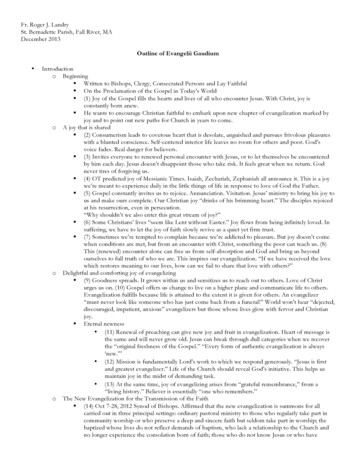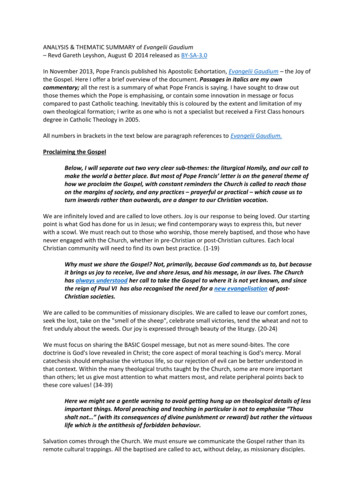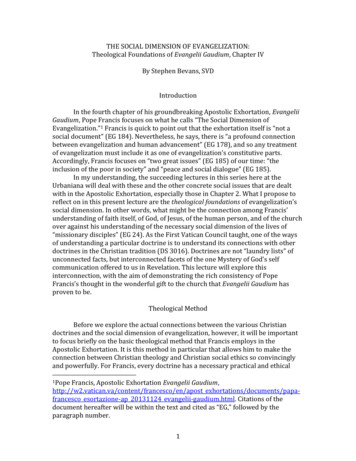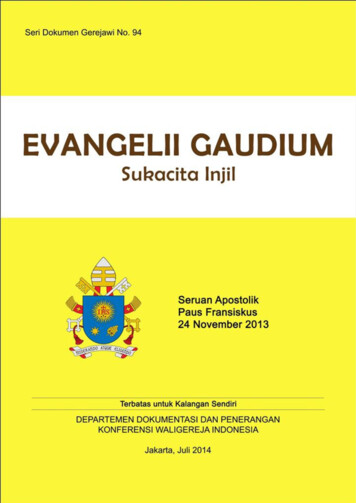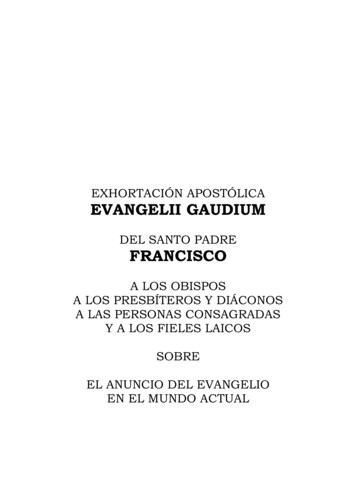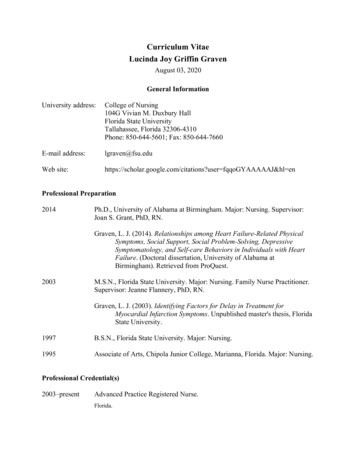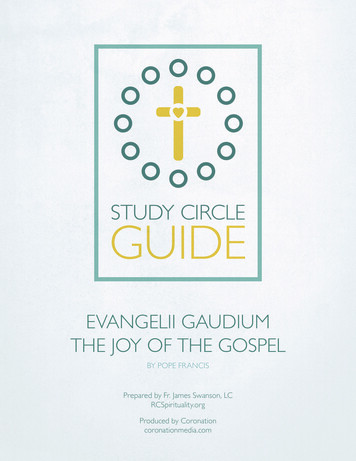
Transcription
EVANGELII GAUDIUMTHE JOY OF THE GOSPELBY POPE FRANCISPrepared by Fr. James Swanson, LCRCSpirituality.orgProduced by Coronationcoronationmedia.com
OVERVIEWEVANGELII GAUDIUM: THE JOY OF THE GOSPELSUMMARYWHO CAN PARTICIPATE?This Study Circle Guide provides an avenue for indepth study of Pope Francis’s Apostolic Exhortation,Evangelii Gaudium—The Joy of the Gospel. This is theHoly Father’s programmatic document. To understandit is to understand how he sees his mission as pope –and therefore our mission as Catholic Christians – inthis moment of Church history.Papal documents are usually dense and written from apoint of view that assumes a lot of basic knowledge ofthe faith. Therefore, it’s a good idea to study this in agroup setting in which the various participants are in asimilar place in their own faith journey.CATEGORIES OF INTERESTCatholic Doctrine; Prayer and Spiritual Growth;ApostolateRECOMMENDED NUMBER OF SESSIONSThe Study Circle Guide contains 6 sessions. Session #1corresponds to the Exhortation’s introduction, whicheach subsequent session corresponds to each of thefive chapters of the Exhortation.The Exhortation, however, is a dense document.Your group may want to take more than 6 sessionsto go through it. The Study Circle Guide has enoughmaterial to spread over more than just 6 sessions.MATERIALS NEEDED Copies of the Study Circle Guide for allparticipants. Copies of the Apostolic Exhortation, EvangeliiGaudium for each participant. Available at theVatican website here:http://www.vatican.va/evangelii-gaudium/en/ For groups with members of the ecclesialMovement Regnum Christi, at least one copy of theRegnum Christi Member’s Handbook (RCMH).RCSPIRITUALITY.ORG : STUDY CIRCLE GUIDEEvangelii Gaudium: The Joy of the GospelAny Catholic interested in going deeper in theirknowledge of the Church and their understanding ofPope Francis’s vision will benefit from this Guide. NonCatholics should understand that the basics of theCatholic faith are assumed by the Holy Father – he doesnot try to explain them all in the Exhortation.The sections on “Questions for Personal Reflection orGroup Discussion” contain numerous references tothe Regnum Christi Member’s Handbook. Participantswho are not members of (or familiar with) the ecclesialMovement Regnum Christi may find little interest inthese questions.HOW MUCH HOMEWORK?The moderator should read the relevant sections of theExhortation in their entirety. The moderator shouldalso read ahead of time the Study and DiscussionQuestions, the Questions for Personal Reflectionor Group Discussion, and the Questions on Livingthe Teaching. A large number of these questions isoffered for the group. The moderator would be wiseto choose ahead of time a few from each section thatwill be most stimulating for the particular needs andinterests of the group.For the rest of the participants, the amount ofhomework will depend on the way in which the Guideis used. The Study Circle Guide for Evangelii Gaudiumcan be used in two ways:1. Individually, it can be used for a profound study ofthe document in which it is hoped the differentparts will help with understanding the document.A dedicated group that is willing to do intensivereading of the document before the Study Circlebegins can use it in the same way.OverviewPAGE 1
2. It can also be used for a group Study Circle in this way:Read the introductory material. Choose the study questions you wouldlike to use. Propose one to the group.The paragraph numbers correspond tothe paragraphs of the document (some‘paragraphs’ are more than a paragraphlong) where the answers can be found.Give the group time to read the paragraphand look for the answer, then members canoffer their answer and discuss it. Move on to another question when you areready. Members of the group can choosequestions that interest them the most. Cover as many questions as you would liketo use or that you have time for.This second method requires little preparation excepton the part of the moderator. It will not achieve thesame depth of understanding of the encyclical, but itmay be the best option depending on the amount oftime participants have available.NOTESRCSPIRITUALITY.ORG : STUDY CIRCLE GUIDEEvangelii Gaudium: The Joy of the GospelOverviewPAGE 2
GETTING STARTEDEVANGELII GAUDIUM: THE JOY OF THE GOSPELBACKGROUND INFORMATIONPURPOSE OF THE EXHORTATIONThe Apostolic Exhortation Evangelii Gaudium—TheJoy of the Gospel—was consigned during the Mass toconclude the Year of the Faith on Sunday, November24, 2013, the Feast of Christ the King. It wasannounced by Archbishop Rino Fisichella, presidentof the Pontifical Council for Promoting the NewEvangelization on Monday, November 18, 2013.1. To promote a definite style of evangelization—“which I ask you to adopt in every activity youundertake”—Francis is telling us what he wants toemphasize in his papacy.The Vatican considers this to be the first officialdocument of Francis’ papacy. It has become traditionalfor the first encyclical of a new pope to include themeshe intends to emphasize during his papacy. Pope Francisdid not do that. His first encyclical, Lumen Fidei, wasinspired by the draft of an encyclical written by BenedictXVI, which Francis rewrote and published under hisown name as a conclusion to the trilogy of encyclicalson the theological virtues started by Pope Benedict.As such, he may have wished to signal continuity withBenedict. However, he clearly indicates that he wantsthis Apostolic Exhortation to be programmatic of hispapacy—to have the place in his papacy that the firstencyclical has had in recent papacies.This document is an Apostolic Exhortation. AnApostolic Exhortation is a category of documentsimilar to an Apostolic Letter. Pope John Paul IIstarted the “trend” of using Apostolic Exhortations tocommunicate to the Church the conclusions he hadreached after consideration of the recommendationsof a Synod of Bishops (a gathering of bishops fromaround the world to reflect deeply on some aspect ofChurch life). He also used it in other circumstances,such as to exhort religious to a deeper evangelicallife. This Apostolic Exhortation follows the XIIIGeneral Assembly of the Synod of Bishops whosetopic was the New Evangelization for the Transmissionof the Christian Faith held in October 2012. TheExhortation’s main theme is the proclamation of theGospel in today’s world. It is addressed to bishops,clergy, consecrated persons and the lay faithful.RCSPIRITUALITY.ORG : STUDY CIRCLE GUIDEEvangelii Gaudium: The Joy of the Gospel2. To present the fruits of the Synod of Bishops held inthe Vatican in October 2012 on the theme “The newevangelization for the transmission of the faith”.3. To present some guidelines and themes that hewishes to discuss in depth. He lists seven of thesein paragraph 17.UNDERSTANDING THE EXHORTATIONThe Holy Father intends the Exhortation to bethe program for a renewal of the Church in thekey of evangelization. He wants the Church’s maincharacteristic to be evangelization.In the Introduction, he reminds us that joy is theconstant outcome of our encounter with a mercifulGod. This message is ever-new and attractive. Thenatural outcome of our encounter with God is to wantto share what we have found. Evangelization is thenatural pattern for all the Church’s activity.In Chapter One, the Holy Father reminds us thatChrist ordered us to give the Good News to allnations. He wants the Church to be renewed bybecoming primarily an evangelizing Church. He goeson to describe how this renewal should take placein different structures in the Church. In presentingthe Gospel, it is most important to start with thepresentation of the saving love of God, rather thanless important truths. In our changing world, itis important to be creative in finding new ways topresent the essential truths of our faith. Pastorally,it is important to patiently accompany people as theyprogress in their faith transformation. The Churchshould be seen as the Father’s house with doors wideopen to the materially and spiritually poor.GETTING STARTEDPAGE 3
In Chapter Two, the Holy Father, without wantingto do a sociological analysis of the situation, names aseries of challenges presented by today’s culture. Hegoes on to present a series of temptations that canslow down or stop pastoral workers.In Chapter Three, the Church is described as a diversepeople in which all are missionary disciples. Thepopular piety of a culture is a way in which a peopleevangelizes itself. This is done person-to-person. Itincludes charisms raised up by the Holy Spirit and afruitful dialog with the various sciences and disciplines.The homily should provide an intense and happyexperience of the Spirit, a consoling encounter withGod’s word, a constant source of renewal and growth.Preaching should be well-prepared, based on the wordof God and done with a knowledge of the lives andneeds of the listeners.Evangelization opens the path to dialogue and is thepath to peace. The Holy Father discusses many kindsof dialogue, noting the importance of each one and itscharacteristics.In Chapter Five, the Holy Father reminds us that asevangelizers filled with the Holy Spirit, we will have ourlives transfigured.We can be as effective as the first Christians inevangelizing if we imitate their life of prayer. Thisimplies a personal encounter with the saving love ofJesus Christ. Drawing near to others out of love forChrist, opens us to the greatest spiritual gifts. Thenew Evangelization will succeed because Christ isalready victorious and his resurrection has becomepart of the fabric of the world. Everything done forhim bears fruit, although not necessarily in the way weexpect. Thus we can work with confidence of victoryand fruitfulness.Evangelization needs to be based on the kerygma (thepreaching of God’s merciful love for humanity) and amystagogical catechesis more than the simple teachingof doctrine. It demands personal accompaniment andis centered on the word of God.In the work of evangelization, Mary assists us like a realMother. She is the model of evangelization who leadsus on in our labors.In Chapter Four, we see that the proclamation of theGospel opens us to each other and to community.Christ redeems not only the individual, but also socialrelationships. The challenge, then, is to build theKingdom of God in society. This implies the Church’steaching on social questions. Christians should becommitted to building a better world.LINKSEveryone must hear and respond to the cry of thepoor. Concern for the common good and the pursuitof it must be the priority. The poor teach us throughtheir experience of suffering. We show concern fortheir spiritual needs.You can find the text of the apostolic exhortation e Vatican’s synthesis of the document can be found ostolic-exhortation-the-joy-ofNOTESBecoming a people in peace requires the practiceof four principles. The Holy Father discusses theimportance of each one: Time is greater than space Unity prevails over conflict Realities are more important than ideas The whole is greater than the partRCSPIRITUALITY.ORG : STUDY CIRCLE GUIDEEvangelii Gaudium: The Joy of the GospelGETTING STARTEDPAGE 4
SESSION 1INTRODUCTION[In this session, you may want to discuss both theintroductory section of the Exhortation, as well as thebackground information in the Getting Started section ofthis Study Circle Guide]SUMMARY OF THE INTRODUCTIONThe encounter with Christ is a liberating experiencethat fills us with joy. Consumerism, marked by acovetous heart, pursuit of frivolous pleasures and ablunted conscience, deafens us to God’s voice, robsus of joy and of the desire to do good. We need toreturn to a personal encounter with Christ. Thatbegins with seeking his forgiveness, which makes itpossible for us to lift up our heads and to start anew.The Old Testament is filled with predictions of thejoy of messianic times. The New Testament invites usconstantly to rejoice. Some Christians live a continualLent without Easter, although nothing can erase joyfrom the heart of someone who has experienced thelove of Christ. Pleasure cannot give this joy. Someonewho has experienced the love of Christ and the joy itbrings automatically wants to share it with others.The Church does not grow by proselytizing but byattraction. Evangelization is the first mission of theChurch. It is the pattern for all the Church’s activity.VOCABULARY NOTEA set of basic assumptions that governhow people think or act. If something is paradigmatic,it means that it contains the principles for how peoplewill think or act in relation to something.PARADIGM:STUDY AND DISCUSSION QUESTIONS1. What does the Holy Father wish to accomplishwith this Exhortation? (Paragraph 1)2. What is the great evil that pervades the world?(Paragraph 2) What are its three attributes that givebirth to desolation and anguish? (Paragraph 2) Whatare the three things that being caught up in ourown interests and concerns can bring about, evenin believers? (Paragraph 2)Good seeks to spread. Joy and fulfillment comesfrom sharing the good we have in our lives withothers. This sharing is not a source of fatigue orlosing something because Christ constantly renewsus. The Gospel message is refreshing; it is constantlynew. The initiative for this evangelization comes fromGod. It demands our generosity. This freshness doesnot change the fact that evangelization is based ona remembrance of the relationship of love betweenChrist and myself, between Christ and his Church.3. What does a renewed encounter with Christconsist of—something which he never tires ofgiving? (Paragraph 3)The new evangelization takes place in threeprincipal settings.6. Although technological society has succeeded inmultiplying occasions of pleasure, it has found itdifficult to do what? (Paragraph 7) Ordinary Pastoral Ministry The baptized whose lives do not reflect thedemands of Baptism
The Apostolic Exhortation Evangelii Gaudium—The Joy of the Gospel—was consigned during the Mass to conclude the Year of the Faith on Sunday, November 24, 2013, the Feast of Christ the King. It was announced by Archbishop Rino Fisichella, president of the Pontifical Council for Promoting the New Evangelization on Monday, November 18, 2013.File Size: 1MBPage Count: 40
